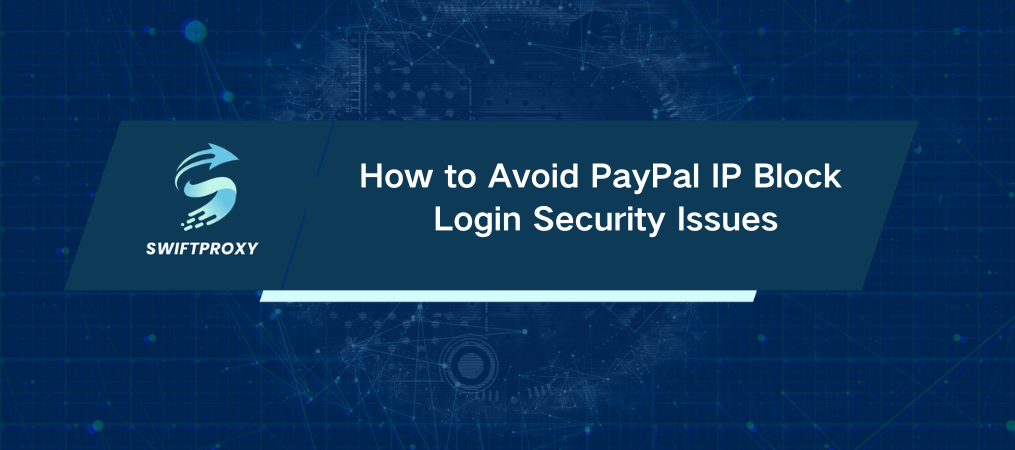How to Avoid PayPal IP Block Login Security Issues

It's frustrating. You're ready to make a payment or register on PayPal, but the platform refuses to cooperate. Whether it's a blocked account, regional restrictions, or payment failures, these hurdles are more common than you might think. The reason? PayPal's strict adherence to geographical policies. But here's the good news: there's a solution. You can bypass these issues by leveraging proxy IP technology. Let's dive in and explore how you can use this powerful tool to regain access to PayPal and secure your online transactions.
PayPal Availability Issues in Your Region
PayPal is a global leader in online payments, but not every user can access its services smoothly. If you've ever faced one of these issues, you're not alone:
Geographical Restrictions: PayPal is unavailable in certain countries, preventing you from signing up or accessing your account.
Account Disabled: If PayPal detects suspicious login attempts, it might temporarily lock your account, halting transactions.
Transaction Failed: Sometimes, transactions fail for reasons tied to your geographic location or IP address.
These problems are often linked to your IP address and PayPal's regional policies. But don't worry, there's a straightforward way to solve this.
What is a Proxy IP and How Can It Help
A proxy IP is a tool that helps you mask your real IP address. When you use a proxy, your requests first go through a proxy server, which forwards them to the destination site (like PayPal). This method not only protects your privacy but also allows you to simulate being in a different region, bypassing geographical restrictions.
Key benefits of using a proxy IP:
Privacy Security: It hides your real IP address, enhancing your online anonymity.
Virtual Location: You can appear to be in a different country or region, bypassing local restrictions.
Risk Reduction: Using multiple proxies can reduce the chances of being flagged or blocked by PayPal.
Why Should You Use a Proxy IP for PayPal
Let's break it down.
Overcome Regional Restrictions: With a proxy, you can appear to be located in a country where PayPal is supported, allowing you to access the platform without issues.
Enhanced Security: When performing sensitive actions (like logging in or transferring funds), a proxy helps reduce the risk of account blocks or suspensions.
Smooth Transactions: Using the right proxy can help you avoid payment failures by making sure your requests align with PayPal's regional policies.
Choosing the Right Proxy IP for PayPal
Picking the right proxy is crucial to ensure smooth access to PayPal. Here's what you need to consider:
Reliability and Speed: A good proxy should be fast and stable to avoid slowdowns or disruptions during transactions.
Anonymous Protection: Ensure the proxy offers high anonymity so PayPal doesn't flag it as suspicious.
Location: Choose a proxy located in a country or region where PayPal is supported. Otherwise, you're still out of luck.
Types of proxies to consider:
Mobile Proxies: Best for transactions on mobile devices, offering a stable connection for mobile payments.
Residential Proxies: These are real user IPs that are harder to detect and typically offer higher security.
How to Set Up a Proxy IP
Ready to get started? Here's a step-by-step guide to set up and use a proxy IP with PayPal:
1. Pick a Proxy Service Provider
Look for reliable proxy providers with a good reputation. Swiftproxy is one of the leading choices.
2. Register and Get Your Proxy IP
After signing up with a provider, you'll usually gain access to a dashboard where you can select your proxy. Make sure to choose one located in a PayPal-supported country.
3. Set Up Proxy Settings
Depending on your device, you'll configure the proxy differently:
API Integration: If you're a developer, you can use an API to dynamically assign proxy IPs via code.
Browser Settings: In your browser's network settings, input the proxy server address and port.
System-Level Proxy: On your operating system, set the proxy for all applications to use.
4. Verify Your Proxy
Before jumping into your PayPal transactions, test your proxy to ensure it works properly. There are websites that can confirm the effectiveness and anonymity of your proxy IP.
How a Proxy IP Saved the Day in Real Life
Let's take User A as an example. User A is based in a region where PayPal doesn't support account registration. After facing multiple failed attempts to create an account, they turned to proxy IPs.
Step 1: User A registers for a residential proxy service.
Step 2: They select a proxy IP based in the United States, a region supported by PayPal.
Step 3: They configure the proxy on their browser and test it.
Step 4: Successful registration. User A is now able to use PayPal without issues.
This real-life case shows just how powerful proxy IPs can be in solving PayPal access problems.
Final Thoughts
Proxy IPs are a powerful way to bypass PayPal's regional restrictions, secure your account, and ensure smooth transactions. But be careful: not all proxies are equal. Choose the right one, configure it properly, and test it first. A poor choice can trigger PayPal IP block login security, locking your account due to suspicious activity. Mastering proxy technology will not only solve PayPal access issues but also enhance your online security.

















































